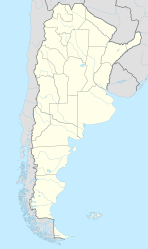El Maitén
| El Maitén | |
|---|---|
| Town | |
| Location of El Maitén in Argentina | |
| Coordinates: 42°03′S 71°10′W / 42.050°S 71.167°WCoordinates: 42°03′S 71°10′W / 42.050°S 71.167°W | |
| Country | Argentina |
| Province | Chubut |
| Department | Cushamen |
| Founded | 22 December 1942 |
| Government | |
| • Mayor | Oscár Rubén Currilén (Justicialist Party) |
| Elevation | 625 m (2,051 ft) |
| Population | |
| • Total | 3,782 |
| Demonym(s) | Maitenense |
| Time zone | ART (UTC-3) |
| CPA base | U9210 |
| Dialing code | +54 2945 |
| Climate | Csb |
El Maitén is a town in Argentina in Cushamen Department on the margins of the Chubut River, on the northwest of Chubut Province, in Patagonia. In older times it was the intermediate point in the railroad tracks of the Old Patagonian Express between the towns of Ingeniero Jacobacci and Esquel.
The town is located 5 km (3 mi) south of the 42 parallel (inter-province border between the provinces of Río Negro and Chubut), at 720 m (2,362 ft) AMSL. Ex-Provincial route 40 runs through it on a north–south direction, which connects to the city of Esquel 135 km (84 mi) south.
Other connecting routes to El Maitén are National Route 243 towards El Bolsón and Bariloche in Río Negro Province, and Provincial routes RP 4 and RP 71, connecting to Cushamen and Epuyén respectively.
El Maitén lies 35 km (22 mi) south of Ñorquincó, 55 km (34 mi) east of El Bolsón, and 70 km (43 mi) northwest of Cushamen, and 30 km (19 mi) northeast of Epuyén.
The town of El Maitén lies on the right margin of the Chubut River. The river's valley is of Glacial origin, and in this region it runs in a North-South direction on the first highlands of the Andes on the West, and the ancient formations of the Patagonia to the East. The topography is mountainous, but of lower elevations, always under 2,000 m (6,562 ft).
This geographic region is a clear example of the transition between the humid wooded Andes areas to the West, and the classic more arid steppes of central Patagonia. Typical native trees of the area are the Austrocedrus chilensis, Coihue (Nothofagus dombeyi), Ñire (Nothofagus antarctica), and over 2,000 meters AMSL the Lenga (Nothofagus pumilio).
...
Wikipedia

